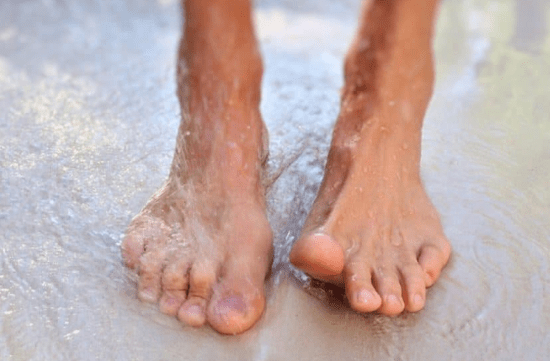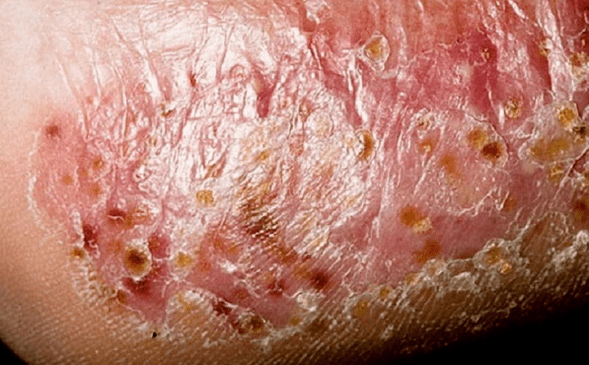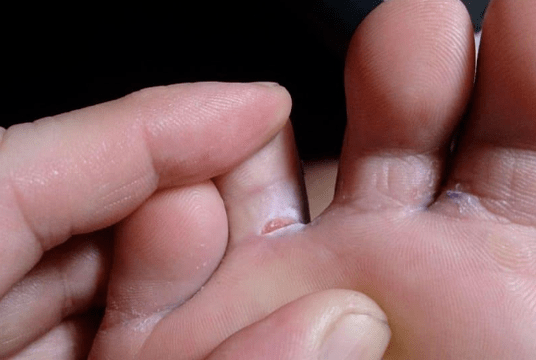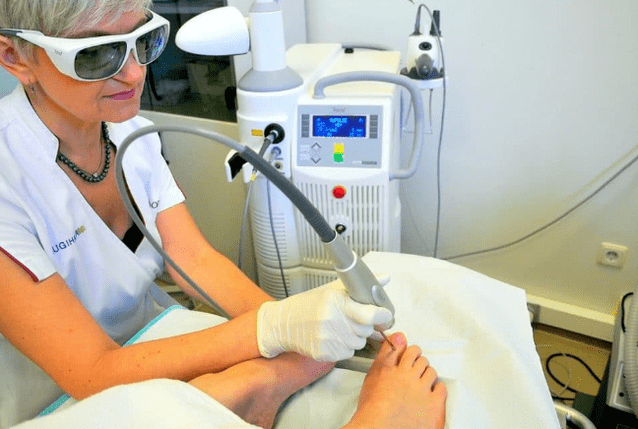This is the general name of infectious diseases that affect a person's foot, nails in the legs or arms.In medicine, these pathologies are called mycose - an entire group of diseases caused by microscopic fungi.
Onychomycosis is distinguished - damage to nails and dermatomycosis - is located in the skin of the legs.The disease is often an independent disorder, as a rule, develops in the context of disturbances of various genesis.As the fungus depends on the foot, the location of the type of pathogen depends.

There are a large number of fungal species, however, only a few cause pathological changes in humans.Feet ringworm occupy the prevalence of 2nd place among all skin diseases.The following groups of fungi are distinguished, which are dangerous to health:
- Anthropophilic.I provoke pathologies only in people, you can be infected with someone else.
- ZooAnthrophilic.They can also cause disease in animals, the infection comes from animals and other people.
- Candidate.A separate type of yeast fungi that has its own characteristics.
There are several types of pathologies that have similar signs, this includes rubromicosis and epidermophythosis.They are combined under the general definition of "Mikoza Stop".The symptoms of fungus in the legs are divided depending on the type, but they usually develop in parallel, so this distinction is conditional.The following forms of pathology are distinguished:
- Scamous;
- Interiginosny;
- Dyshydrotic;
- Onychomycosis, which is divided into: Normotrophic, atrophic, hypertrophic.
The scientific name of the disease is onychomycosis.The infection affects the skin, especially at the lower ends, in nail plaques.Yeast and molds fall on an unprotected surface.
Foot fungus is a very common disease transmitted by people through the general use of objects.It is noteworthy that its distribution occurs extremely rapidly, while the development of the disease is concentrated in the area of the areas between the fingers in the legs.
Causes
Infection into consideration occurs with direct contact with the fungus, whose reproduction occurs extremely quickly in the environment of hot and wet surfaces of the skin.It is possible to infect the fungus of the foot as a result of contact with human skin with its fungus.
The situations where fungus transmission is performed through tools used for manicure and pedicure, as well as through shoes and towels, is no exception.
Most of the time, foot damage occurs between people who have overweight problems and circulation in the blood legs, and people with feet deformation are often subjected to it.Violations in the immune system, caused by an sickly lifestyle, stress, use antibiotics in the treatment of antibiotics, as well as malnutrition, also determine the possibility of foot fungus infection.
Wet skin, cracks, foot irritation, pathogenic and conditionally pathogenic fungi cause pathogenic and conditionally.The types of fungi are as follows:
- Pathogenic species of mushrooms when entering the skin leads to the development of the inflammatory process, there is a fungal disease;
- Conditionally pathogenic microorganisms are constantly on the skin and increased activity manifests only with the action of provoking factors.
The source of infection is people suffering from mycosis.The pathogenic flora enters healthy skin in places of accumulation of people.Comfortably, various types of mushrooms develop in heat and high humidity conditions.
Infection locations:
- Pools;
- Baths;
- changing rooms in sports centers;
- public showers;
- saunas;
- Fitness centers.

Important!Never be barefoot in common areas.For classes at a sports club, the pool, when going to the steam room, take special shoes with you.
Some professions are at risk.The reason is a long stay of the legs in a closed, hot and humid environment.Fungal skin lesions usually suffer:
- Miners;
- Athletes;
- military;
- Hot store workers.
Pay attention!Mycoses usually develop in those who are required to wear closed shoes, regardless of whether they feel comfortable or not.The description of the work for many professions prescribes boots as a special unit, even in the hot season.It is very difficult to combat ringworm under such conditions.
Other causes of fungal diseases:
- bad leg hygiene;
- Skin trauma;
- reduced immunity;
- Adjust shoes without nylon socks;
- Complications for diabetes.
Types and symptoms of a foot fungus
There are many varieties of fungi.
The skin of the feet most often affects the following types:

- Red tricophyte impairs the feet and heels;
- The interdigital tricophyte is distributed to the Interbacking zone and, in advanced cases, affects the feet, the thumb skin and the epidermis on the little finger;
- Tricophite Mentagrophytes - A type of fungal infection that develops on the skin in the human body (armpits, inguinal folds);
- Candida Fungus - Infection causes candidiasis of mucous and genitals membranes, but there are also lesions of the skin of the feet.
Dermatophyte can cause local skin injury.The name of such an disease of epidermophytosis is a very contagious pathology that develops intensively in the human body.
There are three forms of feet fungus:
- Interdalz dermofystosis in acute and chronic forms;
- MOCHACINO-SICUT;
- Vesicular, ulcerative.
The general symptoms of the disease are severe itching and burning, skin irritation, followed by peeling particles.It is these signs that are usually seen in the photo on the internet with which the internet is full.
Interdalz dermofystosis
What is this form?The most common, located mainly between the 4th and 5th finger of the foot.It occurs in the form of cracks: with a damp shape, the skin looks swollen and with a peeled dry piece and falls.
Frequently, along with interdald-filia dermatologists, other bacterial infections are reaching the foot.The advanced form begins.Symptoms are improved and unpleasant sensations - too, the patient feels intense pain that cannot get rid of.
The early stage of the interdigital form of the fungus.
If the skin cracked, the blood can act, causing additional suffering.The psychological factor enters - Some people are trying to start the peeled particles independently from the skin, and this is not recommended to do this as a new infection occurs.The disease is aggravated.
The common name "Foot Athletes" is about this form of fungus on the feet.It is quite difficult, caused by the neglect of treatment, but it is easier to recognize.With this pathology, nail plates are affected, which begin to change color to black, green, blue or yellow.Transparency is lost, nails are gradually deformed, spill and collapse.
The foot at that moment describes, covers with scales on the sides.The leg becomes like a moccasin.
A rather rare form of the disease when compared to interdaltsevo and mochacino-sycut.Bubbles with muddy liquid are manifested across the surface of the foot.Over time, they mature and burst.
The photo is presented with the ulcerative form of the foot fungus
Additional signals noted in patients are:
- pruritus and burning constants;
- Peeling, the skin is lying down;
- The fingertips, which are also infected with a fungus in contact with infected parts of the body;
- swelling of the feet;
- Sometimes body temperature increases a lot.
The causes of disease development
The source of the disease is a person with a foot fungus, whose skin particles remained in objects or in places of public use.It can be baths, swimming pools, changing rooms and showers.Onychomycosis looks great with high humidity and is stable at low temperature.
Most of the time, the causes of disease development are:

- Antisanitria in beauty salons, when pedicure tools do not process or harm it;
- The use of other people's things - towels, cloths, combs;
- Insufficient hygiene, increased leg perspiration.
Non -compliance with hygiene or excessive leg perspiration leads to the fungus of the foot
But contact with the microorganism-exciter is not enough.There are additional risk factors that exacerbate the situation and improve, accelerate the development of the disease.
These include:
- Foot and nail lesions, because when infected, the disease usually changes to the skin;
- Reducing immunity.As soon as this happens, microorganisms begin to attack with revenge, getting rid of them becomes much more difficult;
- HIV infection;
- Bad habits - alcoholism, smoking, eating too much;
- cardiovascular disease, diabetes mellitus;
- Lower ends lympostase.
Stages and their manifestations
The defeat of legs with pathogenic flora microorganisms has several clinical stages or forms of their skin development:
- echoed or early stage;
- interdigital infection;
- Scamous-Hyperkeratotic form;
- Dishydrotic stage (moist fungus).
Popular remedies for fungal treatment
Folk treatment methods can only be used as an auxiliary agent.As the main method of fungal treatment, folkloric remedies are ineffective, but can improve the therapeutic effect of drugs.
First of all, the baths are used.They have an antifungal and steam effect to the skin, improves the penetration of ointment components and fungus solutions in the deep layers of the epidermis.Baths can be made according to the following recipes.
- Add 4 tablespoons of vinegar to the basin with water and cook your legs for 15 minutes.
- Take two tablespoons of salt, soda and iodine solution for 4 liters of water.
- Add the boric acid powder to the bath at a rate of 10 g by 2 liters of water.
- Dissolve four tablespoons of soap in a basin of hot water, add half a glass of soda.
- Add 100 g of soda and juice from a lemon to the bath with water.Fresh juice can be replaced by 10 drops of lemon essential oil.
Baths should be done daily throughout the treatment period.They are recommended to use before applying an antifungal agent.With the foot mushroom, you can use lotions.The tincture of purpose helps to accelerate recovery.It should be mixed equally with water and then moisten a cotton cotton swab in the resulting solution and treat the skin of the legs.
So far, there are many recipes for traditional medicine, whose effectiveness is widely less than some medications.It is noteworthy that a positive result of alternative therapy can only be observed in the early stage of the development of fungal infection.The advanced form of the ringworm of the stop is not subject to traditional medicine.
Traditional medicine medications, like various medications, can be useless in the treatment of leg fungi.But there is such an effectiveness whose effectiveness has been proven for many centuries.
The essential oil of the tea tree is the best medicine that does not cause danger to a general state of health.Therefore, it can be used safely in pediatrics.Due to the presence of anti -support action, the development of pathogenic fungus is blocked under its influence.
To prepare the therapeutic ointment, mix the Aloe Vera gel and tea tree oil in a proportion of 1: 3. This tool is rubbed in the affected areas twice a day.It is recommended that these manipulations be performed daily for three months.



























